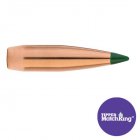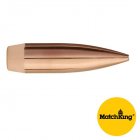What are some of the top most "forgiving" to load or tune 30 cal bullets in your experience?
Are there a couple of go-to 30 cal bullets that most barrels and chamberings seem to shoot well? The Sierra MK with Tangent ogive? Berger Hybrids seem quite tolerant of little to a lot of jump. Do middle weight bullets 155-168 tend to tune up easier or is this more velocity contingent?
I know every barrel is different but are there a couple of 30cal bullets that if a barrel does not like them, it probably won't like anything?
168 & 175 SMK are the most jump forgiving, IME. If you can't get them to shoot with Varget or 4064 then there's probably something wrong with the gun.
155.5 Fullbore, 185 Jugg, Sierra 155 (2156) are easy in my experience.
Most of the SMK's are easy to tune , and the Juggs as well . I've found the Berger Hybrids to be somewhat "depth" sensitive in two different brand barrels . But they shot well at either .005 , or .020 off touch . The 200.20x varies from barrel to barrel , but not hard to find with a normal seating test . The 215 Berger isn't difficult . Same as the 20x . I shoot Berger , so I can't tell you about those "other" brands .
Thank you all for the replies! That is the type of info I was hoping to get.
Any bullet that has a tangent ogive will likely be more forgiving and perhaps a bit easier to tune than bullets with hybrid or secant ogives. Although it's usually not too difficult to distinguish tangent and secant ogive bullets from a good side-view picture, hybrid bullets may be a bit more difficult. The transition from ogive to bearing surface in a tangent ogive bullet is very smooth and rounded, whereas a secant ogive bullet has a noticeable sharp or abrupt corner at the transition. Regardless, a call to the manufacturer should be able to clear up any questions as to the bullet ogive type, if necessary. Bullets in the 155 to 168 gr range are not necessarily "more forgiving" to tune. However, it's likely that a far larger number of rifles are equipped with barrel twist rates and throated for bullets of this length (weight), especially commercial production rifles.
That is why in addition to selecting the more forgiving tangent ogive bullet type, you will also need to know approximately how much free-bore the rifle has (i.e. how long is the rifle chamber throated?), as well as the barrel twist rate. The amount of free-bore dictates how much bullet bearing surface will be seated in the case neck when seated close to the lands, and the twist rate needs to be sufficient to stabilize whatever bullet weight (length) you select. Using those criteria, you ought to be able to choose a tangent ogive bullet that is appropriate for your rifle's twist rate and free-bore that should tune in readily. Without those two critical pieces of information, any specific bullet suggestions made here are not necessarily guaranteed to work well. If you have the twist rate and free-bore length numbers, posting them here might allow for more specific recommendations by other members of the forum. Alternatively, bullets such as the Berger 155.5 Fullbore, 175 OTM Tactical, 185 Juggernaut, and the SMK 155 (2156), 168 and 175, would be potentially good choices, as have already been mentioned.
185 Berger Juggernaut is the easiest I have shot.
Back in the Day
Gold $$ Contributor
The 175 SMK Tipped bullet was as easy as I've ever tried. 1/4 to 3/8 inch groups are common out of my Custom REM 700 1 - 10 Tw. by (WSMNUT)
-

308 - 175 SMK.jpg
392.7 KB
· Views: 27
For me its 185gr Juggers and 215gr Hybrids
As a general rule,I have found Tangent ogive bullets to be more forgiving.As has already been said,if Matchkings don't shoot well,it's very possible that nothing else will.They are very tolerant of length/seating depth.On the other end of the spectrum,I've found the VLD/ELD/RDF super streamlined bullets can be a challenge to get to shoot well.Another family of bullets that are easy to get to shoot at different lengths are the Berger Classic Hunters.They again aren't as long and sleek as most of their bullet designs,but they are easy to load and very length tolerant.The Sierra Tipped Matchking seems to be more finicky than its hollow point kin as far as length goes,and I've found that to be true with several 308's that I have worked with.But when you hit the right length for the TMK,wonderful things happen.
SMKs and Amax have been user friendly for me. I've had great luck with Berger's too but they can be pretty stubborn at times. Scenar's are an easy tune as well.
Thank you all for the input!
As a general rule,I have found Tangent ogive bullets to be more forgiving.As has already been said,if Matchkings don't shoot well,it's very possible that nothing else will.They are very tolerant of length/seating depth.On the other end of the spectrum,I've found the VLD/ELD/RDF super streamlined bullets can be a challenge to get to shoot well.Another family of bullets that are easy to get to shoot at different lengths are the Berger Classic Hunters.They again aren't as long and sleek as most of their bullet designs,but they are easy to load and very length tolerant.The Sierra Tipped Matchking seems to be more finicky than its hollow point kin as far as length goes,and I've found that to be true with several 308's that I have worked with.But when you hit the right length for the TMK,wonderful things happen.
WVRJ or others, any idea why the TMK may be more finiky than the not tipped MK's?
Would a shorter bullet with a lower sectional density tend to be more forgiving than a longer (heavier) bullet with a similar ogive?
Thank you all for the input!
WVRJ or others, any idea why the TMK may be more finiky than the not tipped MK's?
The TMKs have a Secant design where the other MKs have the Tangent design. See pics below and note the difference in shape between the ojive and the tip. This is why.


185 Berger Juggernaut is the easiest I have shot.
We will see!
I know its not a target bullet but nosler ballistic tips shot well in my 308 over a Pretty large seat depth window
I had no idea the TMK were secant. Just ass-u-me-d they were tangent like MK. That is interesting. Thank you!
Would a shorter bullet with a lower sectional density tend to be more forgiving than a longer (heavier) bullet with a similar ogive?
Not necessarily. As long as the chamber and barrel are optimized appropriately for a given bullet length/weight, loads with lighter/shorter bullets or heavier/longer bullets can be readily tuned in, with no real noticeable difference in "ease of tuning".
LOL, thats probably true. But I have never shot them so I cant speak from experience. But they do look that way. None of us want to hear it until we can get some though, so keep it to yourself!













